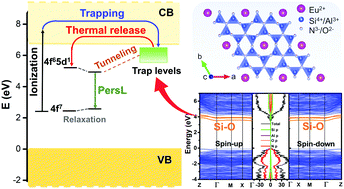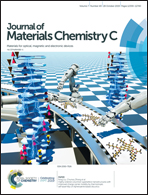Green persistent luminescence and the electronic structure of β-Sialon:Eu2+†
Abstract
Divalent europium doped aluminum silicate oxy-nitride (β-Sialon:Eu2+) has been widely used in backlights for liquid-crystal displays due to its outstanding green emission properties. Herein, the persistent luminescence (PersL) performance and electronic structure of β-Sialon:Eu2+ with the general formula Eu0.015Si5.5Al0.485O0.515N7.485 are first reported. The PersL duration is observed to be 400 s after 254 nm irradiation. By virtue of density functional theory (DFT) calculations, we verify that the trap levels responsible for PersL are impurity levels induced by Si–O bonds located below the bottom of the conduction band (CB) on random substitution of Al–O for Si–N in β-Si3N4. The trap depth and density are estimated through experimental data. The charging process for PersL is clarified by the thermoluminescence excitation (TLE) spectrum. The electronic structure diagrams (host referred binding energy, HRBE and vacuum referred binding energy scheme, VRBE) of β-Sialon:Eu2+ are constructed to deeply understand the PersL mechanism and luminescence behavior. We propose a novel strategy to construct the HRBE schemes, i.e. using the onset energy of the thermoluminescence excitation (TLE) spectrum as the energy difference between the 4f ground state and the bottom of the CB to pinpoint the 4f energy level location of Eu2+. This work would allow more rational design of luminescent materials.



 Please wait while we load your content...
Please wait while we load your content...